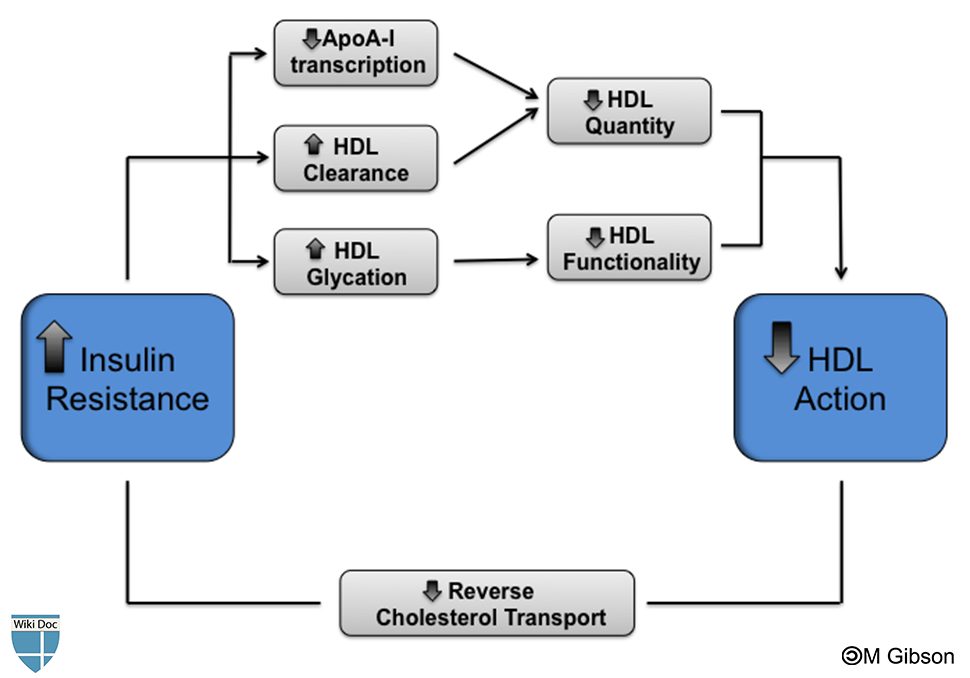High density lipoprotein pathophysiology
|
High Density Lipoprotein Microchapters |
|
Diagnosis |
|---|
|
Treatment |
|
Clinical Trials |
|
Case Studies |
|
High density lipoprotein pathophysiology On the Web |
|
American Roentgen Ray Society Images of High density lipoprotein pathophysiology |
|
Risk calculators and risk factors for High density lipoprotein pathophysiology |
Editor-In-Chief: C. Michael Gibson, M.S., M.D. [1]; Associate Editor(s)-in-Chief: Rim Halaby, M.D. [2]
Overview
Insulin resistance contributes to a decrease in HDL number as well as functionality, which culminates in a decrease in the overall action of HDL in the body.[1] Low HDL levels, exacerbates insulin resistance and consequently lead to a self perpetuating cycle of increment in insulin resistance and decrement in HDL action.[2][3] Diabetes mellitus type II and visceral obesity, especially in genetically predisposed individuals, lead to low HDL through its contribution to insulin resistance.
Pathophysiology
Insulin Resistance
- Insulin resistance, secondary to obesity and type II diabetes, contributes to dyslipidemia by increasing triglyceride and total cholesterol and decreasing HDL. And in return, dyslipidemia, including low HDL levels, further exacerbates insulin resistance leading to a self perpetuating cycle of increase insulin resistance and decrease HDL action.[2][3]
- Insulin resistance contributes to a decrease in HDL's number as well as functionality, which culminates in a decrease in the overall action of HDL in the body.[1]
- There are several mechanisms by which insulin resistance contributes to low HDL action. In fact, insulin resistance downregulates ApoA-I transcription and increases HDL clearance which leads to decreased HDL levels.[4][5] In addition to lowering HDL levels, insulin resistance lowers HDL functionality by glycation of HDL particles.[1][6]
- Genetic predisposition also contributes to these mechanisms rendering some individuals more susceptible to having insulin resistance and dyslipidemia than other people.[2][7]
Shown below is an image depicting the self perpetuating bidirectional relationship between insulin resistance and low HDL.

Adapted from Nature Reviews Endocrinology.[2]
References
- ↑ 1.0 1.1 1.2 Hoang A, Murphy AJ, Coughlan MT, Thomas MC, Forbes JM, O'Brien R; et al. (2007). "Advanced glycation of apolipoprotein A-I impairs its anti-atherogenic properties". Diabetologia. 50 (8): 1770–9. doi:10.1007/s00125-007-0718-9. PMID 17579831.
- ↑ 2.0 2.1 2.2 2.3 Drew BG, Rye KA, Duffy SJ, Barter P, Kingwell BA (2012). "The emerging role of HDL in glucose metabolism". Nat Rev Endocrinol. 8 (4): 237–45. doi:10.1038/nrendo.2011.235. PMID 22271188.
- ↑ 3.0 3.1 Ginsberg HN (2000). "Insulin resistance and cardiovascular disease". J Clin Invest. 106 (4): 453–8. doi:10.1172/JCI10762. PMC 380256. PMID 10953019.
- ↑ Pont F, Duvillard L, Florentin E, Gambert P, Vergès B (2002). "High-density lipoprotein apolipoprotein A-I kinetics in obese insulin resistant patients. An in vivo stable isotope study". Int J Obes Relat Metab Disord. 26 (9): 1151–8. doi:10.1038/sj.ijo.0802070. PMID 12187390.
- ↑ Vajo Z, Terry JG, Brinton EA (2002). "Increased intra-abdominal fat may lower HDL levels by increasing the fractional catabolic rate of Lp A-I in postmenopausal women". Atherosclerosis. 160 (2): 495–501. PMID 11849676.
- ↑ Calvo C, Ponsin G, Berthezene F (1988). "Characterization of the non enzymatic glycation of high density lipoprotein in diabetic patients". Diabete Metab. 14 (3): 264–9. PMID 3137109.
- ↑ Daimon M, Kido T, Baba M, Oizumi T, Jimbu Y, Kameda W; et al. (2005). "Association of the ABCA1 gene polymorphisms with type 2 DM in a Japanese population". Biochem Biophys Res Commun. 329 (1): 205–10. doi:10.1016/j.bbrc.2005.01.119. PMID 15721294.